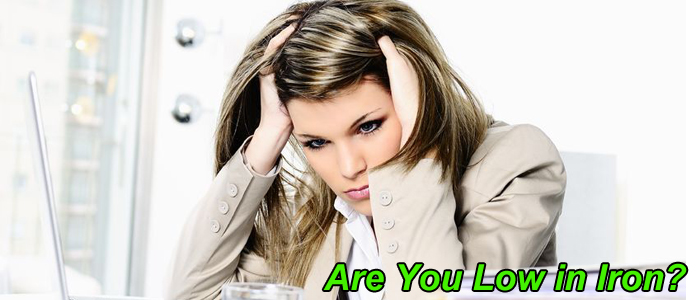Are You Low in Iron?

Do you ever feel terribly fatigued or run-down during the day? Do you notice that you have a difficult time concentrating or feel that you cannot think straight? Do you feel cold even though the temperature outside is pleasant? Do your hair and nails feel brittle, or are you experiencing hair loss? Is your skin ashy, dull, or pale? If you answered “yes” to any of these questions you may be suffering from low iron.
In general, women of childbearing age are most at risk of low iron, because they lose iron-rich blood every month during their menstrual periods. Naturally, of this group, women who experience heavy menstrual periods are most at risk. Vegans and vegetarians are also subject to low levels of iron because they exclude certain high-iron-containing foods, like meat, from their diets. People who have kidney disease or digestive issues can also face problems with low iron because their bodies cannot properly absorb the mineral. Young children, too, are susceptible to having low levels of iron in their blood and need to be monitored.
Why is iron so important? Iron is responsible for the creation of hemoglobin, the substance in red blood cells which carries oxygen to your body’s tissues. When there is not enough iron in your blood, and subsequently not enough oxygen getting to your cells, your body will have to work harder to produce more oxygen and you end up feeling fatigued. Iron also plays a large role in ensuring your immune system is working at its best and it properly metabolizes vitamin B, another essential vitamin.
Did you know that you can have a normal red blood count, but still be iron-deficient? The one test you should ask for from you doctor to confirm a low-iron level is a ferritin level blood test. This test will show how much iron you have stored in your body and will tell the doctor whether or not you need to begin iron supplements or improve your diet.
The good news is that you can begin to naturally build up the levels of iron in your blood almost immediately. The simplest and most effective way to do that is by changing the way you eat. There are two types of iron present in our food: heme and non-heme iron. Heme iron is found in meats and it is absorbed into your system two to three times more quickly than non-heme iron. Good sources of heme iron include red meat, chicken livers, oysters, and clams. Non-heme iron is found in plant-based foods, especially beans, fortified cereals, spinach, and broccoli.
There are certain tips you can follow to increase your iron intake when eating. First, combine foods and drinks that contain vitamin C with iron-rich foods to boost iron absorption. Oranges and other citrus fruits, red peppers, and dark, leafy greens are some of the foods high in vitamin C. Next, don’t drink coffee or tea too close to an iron-rich meal. The tannins in these drinks block the absorption of iron. Wait to eat your healthy iron-filled food at least three hours after consuming coffee or tea to maximize your iron intake. Finally, consider using a cast-iron skillet when cooking foods. Some of the iron from the skillet will be transferred to your foods making them instantly more iron-rich.
Sometimes, getting iron from your diet is not enough to ensure healthy iron levels. After receiving the results of your ferratin level blood test, your doctor may recommend you take an iron supplement in addition to initiating dietary changes. Be sure not to take iron supplements without consulting your doctor first. It is necessary that your doctor find out why your iron levels are low to begin with so he or she can treat the underlying cause if appropriate. Also, having too much iron stored in your body is dangerous. It can harm your liver, cause cancer, or cause heart disease. It is important that you are monitored properly by your physician when taking iron supplements.
The next time you are feeling tired, cold, or just plain out-of-it, consider whether or not you might have low iron stores. Consult your physician for a test and see whether you can improve your iron through a healthy diet or if you need a dietary supplement. After starting treatment, you may see that within a few days you might feel more energetic and ready to take on the world.
Please visit the Educational Corner for our collection of current and past educational articles. The archive includes five categories: Health & Wellness, Massage & Bodywork, Product, Home Massage and Business. From massage research, product spotlights and detailed techniques to DIY self-care and business tips, browse our varied list and learn more.
We offer monthly newsletters to our valued customers. Each issue features new products, exciting releases, the latest news, educational articles and special exclusive offers. It’s easy and FREE. Please sign up here.






